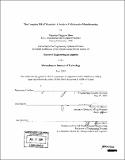| dc.contributor.advisor | James M. Masters. | en_US |
| dc.contributor.author | Hwu, Timothy Tingyaw, 1977- | en_US |
| dc.contributor.other | Massachusetts Institute of Technology. Engineering Systems Division. | en_US |
| dc.date.accessioned | 2005-09-27T17:01:48Z | |
| dc.date.available | 2005-09-27T17:01:48Z | |
| dc.date.issued | 2003 | en_US |
| dc.identifier.uri | http://hdl.handle.net/1721.1/28562 | |
| dc.description | Thesis (M. Eng. in Logistics)--Massachusetts Institute of Technology, Engineering Systems Division, 2003. | en_US |
| dc.description | "June 2003." | en_US |
| dc.description | Includes bibliographical references (p. 51). | en_US |
| dc.description.abstract | The effects of the bill of material on outsourced manufacturing environment are studied by gathering information on costs to implement a new bill of materials (BOM) transfer process, the potential gains to maintaining a complete bill of material versus the partial or complete embedding of data, and surveying the high-tech electronics manufacturing industry's practice in communicating the bill to their partners. This thesis deals with a telecommunications products company fictitiously named Telcom and its contract manufacturing partners. While much of the cost involved is the price of implementing an Information Technology system to handle manufacturing collaboration, the heart of the issue is the management of the BOM data. Thus, the inclusion of the often undocumented cost or benefits of migration and ongoing coordination and support would further complicate the decision to implement. Furthermore, downstream efforts in supporting this process change and the manufacturer's interests in providing quality and timely service to their partners implies a need to transmit the fully detailed or "exploded" BOM. In some cases, the company's engineers were reluctant to express support for the exploded BOM due to the expected significant workload increase, the perceived added cost in maintaining extra part numbers, and the low expectation of returns for the endeavor. When approached by the prospect to receive standardized formatting but a partially embedded BOM however, the manufacturers expressed concerns regarding lead time elongation and quality degradation. The results on the comparison of the expected costs and benefits of implementation suggest a need for a delivery of a consistently formatted and complete bill of material. | en_US |
| dc.description.statementofresponsibility | by Timothy Tingyaw Hwu. | en_US |
| dc.format.extent | 56 p. | en_US |
| dc.format.extent | 2566215 bytes | |
| dc.format.extent | 2570980 bytes | |
| dc.format.mimetype | application/pdf | |
| dc.format.mimetype | application/pdf | |
| dc.language.iso | en_US | |
| dc.publisher | Massachusetts Institute of Technology | en_US |
| dc.rights | M.I.T. theses are protected by copyright. They may be viewed from this source for any purpose, but reproduction or distribution in any format is prohibited without written permission. See provided URL for inquiries about permission. | en_US |
| dc.rights.uri | http://dspace.mit.edu/handle/1721.1/7582 | |
| dc.subject | Engineering Systems Division. | en_US |
| dc.title | The complete bill of materials : a study in collaborative manufacturing | en_US |
| dc.type | Thesis | en_US |
| dc.description.degree | M.Eng.in Logistics | en_US |
| dc.contributor.department | Massachusetts Institute of Technology. Engineering Systems Division | |
| dc.identifier.oclc | 57454866 | en_US |
